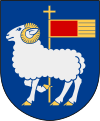Gotland Island

Coat of arms
|
|

Gotland (Sweden)
|
|
| Geography | |
|---|---|
| Location | Baltic Sea |
| Coordinates | 57°30′N 18°33′E / 57.500°N 18.550°E |
| Archipelago | Slite archipelago |
| Total islands | 14 large + a number of smaller |
| Major islands | Gotland, Fårö, Gotska Sandön, Furillen |
| Area | 3,183.7 km2 (1,229.2 sq mi) |
| Length | 176 km (109.4 mi) |
| Width | 52 km (32.3 mi) |
| Coastline | 800 km (500 mi) (including Fårö) |
| Highest elevation | 82 m (269 ft) |
| Highest point | Lojsta hed |
| Administration | |
| County | Gotland County |
| Municipality | Gotland Municipality |
| Largest settlement | Visby (pop. 23,600) |
| Demographics | |
| Population | 57,221 (2009) |
| Pop. density | 18.25 /km2 (47.27 /sq mi) |
Gotland (/ˈɡɒtlənd/; Swedish pronunciation: [ˈɡɔtland], older spellings include Gottland /ˈɡɒtlənd/ or Gothland /ˈɡɒθlənd/,), Gutland in the local dialect Gutnish, is a province, county, municipality, and diocese of Sweden. It is Sweden's largest island. The province includes the small islands of Fårö and Gotska Sandön to the north, as well as the even smaller Karlsö Islands (Lilla and Stora) to the west. The population is 57,221, of which about 23,600 live in Visby, the main town. The island of Gotland and the other areas of the province of Gotland make up less than one percent of Sweden's total land area.
...
Wikipedia
